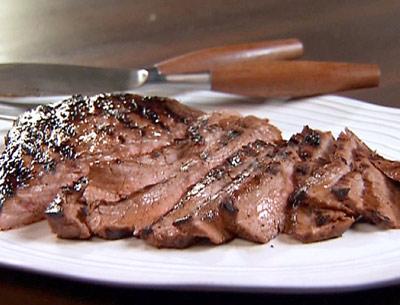Seasons by the Sea: Tender, Tastier, Healthier

If you are like 99 percent of the population out here in the summertime, you are probably grilling and barbecuing many of your meals.
We have already covered the gas versus charcoal debate in this column, but have never discussed the importance of marinades. Marinades can make the difference between an okay piece of meat and a tender, flavorful one. Marinades can make a cheaper cut more palatable and interesting. Anybody can throw an unseasoned rib-eye steak on the barby and it will be delicious. But to take an inexpensive skirt or flank steak that has been bathing in soy sauce, garlic, and ginger for 24 hours, then quickly sear it and slice it against the grain, that is creative and practical. Of course, marinades aren’t just for meat; fish and vegetables can benefit from some additional flavor infusion, too.
Marinades serve multiple purposes. Centuries ago marinades were often used after meats or fish were cooked. The acid properties act as a preservative. For tougher cuts, marinades act as a tenderizer, for vegetables and fish they are simply a flavor enhancer.
Basically, an oily marinade will give lean, dry meat the fat needed to make it more appetizing and an acid liquid will tenderize. Marinating small fish in lemon or lime juice will achieve the same effects as cooking. Salt and other flavorings have a preservative effect.
It is important to remember that if tenderizing and flavoring are your goal (such as with a butterflied leg of lamb), overnight marinating is suggested. For fish, just an hour will do. It is also essential to never put the cooked meat or fish back into the bowl or platter that contained marinade unless it has been washed. Additionally, if you wish to use some of the marinade as a sauce after cooking with it, it must be boiled for at least five minutes. If you’re a nervous Nelly, simply make an extra batch of the marinade to serve alongside.
In Western cooking, marinades date back to the Renaissance when people would marinate meats and seafood in vinegar and spices both to preserve and flavor them. In the days before refrigeration the food was cooked first, then a marinade was poured over. Koreans have been marinating beef in soy sauce, sugar, garlic, and sesame oil since the 1500s. The Spanish introduced escabeche, a vinegar-based sauce, to Latin America in the 16th century. In Brazil and Argentina meats were often just salted and grilled, then enhanced with sauce at the table.
Marinades can be tailored to suit whatever you are cooking. The acid, or tenderizing component, needn’t be just vinegar or citrus juice. Wines, buttermilk, yogurt, and even other fruit juices such as pineapple or kiwi work well. You can use olive oil (no need for an expensive one) or any other neutral oil. For a Tuscan-style marinade add red wine, oregano, rosemary, bay leaves, onion, and orange rind. For Indian style tandoori chicken, mix some cumin, cardamom, garlic, and ginger into yogurt. For vegetables on the grill, some milder herbs such as chives and basil will enhance the flavor.
The ideal container for marination is a big Ziploc bag, as this ensures that all surfaces of the meat are covered. Otherwise, any non-reactive bowl or dish will do. Be sure to cover and refrigerate whatever you are marinating.
If you are short on time, bottled dressings make an easy marinade. Years ago, Wishbone Italian dressing was the go-to for barbecued chicken. There are also some decent bottled marinades, such as SoyVay, with the best product name ever!
If being outside while you cook with no pots or pans to wash afterward isn’t enough to convince you, then this factoid could encourage you to get marinating and grilling. According to the National Cancer Institute, marinating food before barbecuing significantly reduces the levels of carcinogens. Or to get really technical, the acids in marinades reduce the heterocyclic aromatic amines.
Here are some recipes to inspire you, including one from The Star’s very own Russell Drumm, the Barbecue King.
Click for recipes
